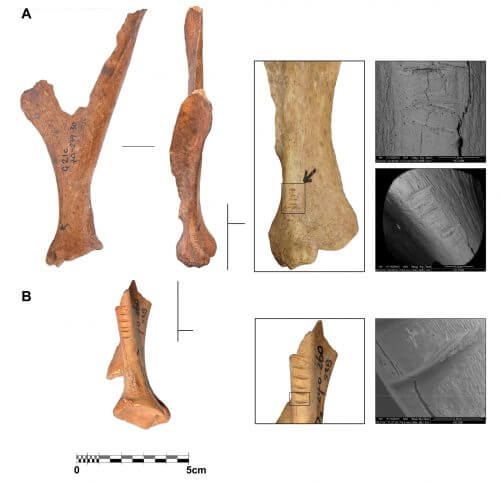Processed deer bones found in the Galilee (in the Pigeon Cave) were used as markers of a unique cultural group that came to Israel from Europe for a short time tens of thousands of years ago

Already in the early stages of human history, distinct cultural entities existed with characteristics that set them apart and differentiate them. The new research, a collaboration between Dr. Tejero, from France (research leader), Prof. Anna Belfer Cohen and Dr. Rivka Rabinowitz from the Institute of Archeology at the Hebrew University, Prof. Ofer Bar-Yosef (Emeritus from Harvard University) and Dr. Vitali Gutkin from the Nano Center of the Hebrew University, deals with one of the cultural entities that existed in the Levant (Israel, Jordan, Lebanon, Syria). The entity's name is the "Levantine Aurignacian" and it existed for a relatively short period of time, between 38,000 and 35,000 BC, in our regions.
The new study examined the bone vessels of the Levantine Aurignacian in the Cave of Pigeons in the Western Galilee, and discovered a new cultural sign of this entity - these are the bones of a deer that were worked in a certain way and cut, with the grooves appearing in a fixed area on the surface of the bone. It is likely that this is an item unique to the local Aurignacian culture that may have been a marker of belonging to a group, sewn into clothing, or as a pendant, to distinguish its people from members of other groups that lived at the same time in the same space. This is in contrast to other objects that are used for daily activities such as hunting, food preparation or processing hides.
The remains of the culture that have been preserved (stone tools, bone tools and horn) are very similar to those of the Aurignacian entity in Europe - which existed in Western and Central Europe for years, before and after the Levantine one. That is, there is a working assumption that the Levantine Aurignacians came here from Europe, lasted a relatively short time, and then disappeared or merged with the local cultural entities.
The distribution of this entity is limited to the Mediterranean climate zone, and it is known in caves such as El Wad Caves, Kabara in Carmel, Manot in the Galilee and Kasar Akil on the coast of Lebanon. It appeared in our regions while interrupting in some sites the sequence of local cultures that continued to exist in part at the same time, and their successors took its place with its disappearance.
The researcher, Dr. Rivka Rabinovitch explains: It was interesting to systematically check the nature of these items that at first glance resembled items that are the result of dismemberment (grooves created by the contact between the sharp tool, made of flint, and the bone during the dissection of the animal and the removal of the meat), and to prove to what extent they Different. Microscopic, comparative observations as well as observations using the scanning electron microscope (which has become an important tool in archaeological research) clarified the uniqueness of the signs. At the end of each such observation, the question remains as to what they were really used for. This is the most fascinating part, trying to understand the behavior that is not necessarily related to survival. As always, every researcher contributed from his expertise and especially the research leader Dr. Tejero, who specializes in tools made of bone and horn and also works on simultaneous assemblies in Europe.

4 תגובות
Be first!
Ben Porat Yosef,
In such a case, the article can be retroactively deleted using quantum erasure
J. Purat the Honorable.
What do you think the screen saver was invented for?
Excuse me, where is the curtain behind it, will it be possible to hide the news if some Haredi appears here?